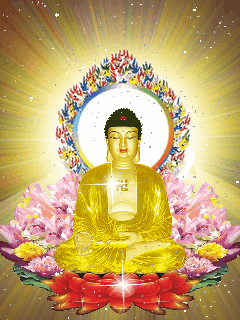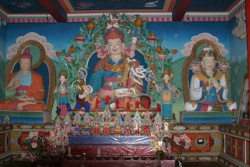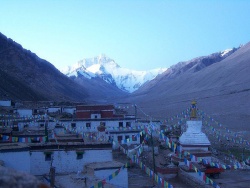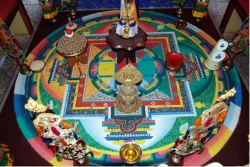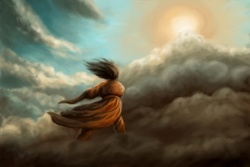Delog: Journey to Realms beyond Death
Abstract: Delog: Journey to Realms Beyond Death tells the story of a 16 year old delog, Dawa Drolma’s journey to various realms after death.
Delog refers to a person who has died, visited the realms of heaven and hell, the bardo, and returns to tell the tale.
Born in the early 20th century, Dawa Drolma lived most of her life in Central Tibet outside of Lhasa and died in 1941.
She was revered as a lama and dakini and was well known throughout the region as a delog.
To become a delog, Dawa Drolma made the conscious choice to induce a death like state.
At the age of 16 she traveled for five days through the Pure Realm of Padmasambava, the Impure Realms of Being, the Pure Realm of Avalokiteshvara, and the Pure Realm of Tara.
Transcribed shortly after her revival by Gyazur Tulku the story was later translated by Robert Barron in 1995.
A phenomenon known for centuries throughout Tibet and the Himalaya, “delog” refers to a man or woman who has died, traveled through the various realms between life and rebirth and then reawakens to tell the tale.
Born in the early 20th century and living only to her early thirties, Delog Dawa Drolma was well known throughout Central Tibet as a lama, dakini, and delog.
From a young age Dawa Drolma experienced a number of beneficial visions and dreams, most notably a prophecy from the wisdom goddess White Tara who would be Dawa Drolma’s guiding figure throughout her life.
Compelled to seek what was virtuous, Dawa Drolma convinced her lama to aid in reaching the realms beyond death.
At the age of 16 after giving specific instructions for the rituals and keeping of her body, Dawa Drolma entered into the Pure Realm of Padmasambava.
Over the course of five days she passed through the Pure Realm of Padmasambava, the Six Impure Realms of Being, Potala Mountain or the Pure Realm of Avalokiteshvara and the Yulokod or the Pure Realm of Tara.
Recognized as an emanation of White Tara, Dawa Drolma made a pilgrimage to Lhasa where she conceived her first child and later lived at the monastery, Tanp’hel Gonpa, seven miles outside Lhasa until her premature death from childbirth in 1941.
For the purposes of this discussion I will analyze the tale in its entirety through major events, themes, and characters.
When Dawa Drolma told her high lamas that she planned to enter into a, “state of deep meditative stability, as though in a coma or in a state like death,”
(4) they were surprised and slightly aghast.
They presented other options but Dawa Drolma stood fast in her objective.
She made specific preparations in order to perform the process correctly.
First, on the day she informed everyone of her plan, they held a special meditative session that evening with lamas and students.
Dawa Drolma says that she recited liturgical texts that she had yet to study.
This potentially implies that the ritual of speaking the text out loud was more important than being a full adept in this particular context.
Waiting until the evening also had significance; early morning is associated with pacification, late morning with enrichment, afternoon and early evening with power, and the later evening with wrathful energy.
Dawa Drolma specifically says that she was waiting for the time when dakinis, female embodiments of enlightened energy, gathered (7).
Soon after the meditative session, Dawa Drolma gave her lama Tulku Tromge Trungpa specific instructions, “During [my time in death none of the monks or students should go in or out of my room…
Remove all food stuffs that are in my presence...to purify [my body…wash me with saffron water that has been consecrated through the practice of Vijaya.
At that time, to provide a particular auspicious condition, there should be a girl present named Drolma”
(7). The last request is significant because the name Drolma is the Tibetan equivalent of the Sanskrit Tara (143).
There were many other requests she implored people to conduct while she was in the death like state, including wrapping a blue cloth around her head symbolizing the transformation of anger into pristine awareness, performing the offering of oblations to the five goddesses of Lhaman Tsering, and reciting the Seven Line Supplications and the prayer Dispelling Obstacles on the Path.
Dawa Drolma finally acknowledged that she might not reawaken and made the necessary preparations.
As she entered into the state of death she felt, “fully aware of the fundamental condition of my mind…it was as though I could hear all sounds and voices in all lands” (8).
As a woman, it is not surprising that a large number of the beings Dawa Drolma encounters on her journey are female.
However, a subtle yet fascinating element of her interactions with women is that, compared to men, the female beings are far more interested in speaking with her and even go out of their way to know her.
An important dakini Yeshe Tsogyal delighted in Dawa Drolma and gave her special information regarding Dawa Drolma’s uncle, a renowned lama, and later offered her a special prayer (28), while dakini Laykyi Wangmo, “showed heartfelt joy” (17) towards Dawa Drolma.
One male lama acknowledged Dawa Drolma but it wa his dakini consort who spoke out to her (12) while another male lama in the Realm of Padmasambava, “seemed to have a very harsh and intractable character: he spoke not a single word and deliberately avoided looking at me” (12).
Furthermore, almost every gatekeeper or attendant the Pure Realms was female and Dawa Drolma appeared to speak and have relations with them as well.
In the Pure Realm of Padmasambava we are immediately introduced to her guide the White Tara who accompanied Dawa Drolma through all four realms.
Dawa Drolma’s karmic connection with Tara was evident throughout her tale, as she was referred to as, “O woman of Tara” (109).
Most significant however is the episode in the Yulokod Pure Realm of Tara where Tara placed her hand on Dawa Drolma’s head saying, “O lovely maiden, Chandra Tara…when I gave rise to excellent bodhicitta, there was no one who aspired to perfect buddhahood in a woman’s body.
Therefore, I conceived the following aspiration: ‘I will appear in the forms of women” (121).
This declaration gave Dawa Drolma extreme happiness and made clear her connection to Tara and the many women in the realms beyond death.
Before describing her visionary experiences of hell, Dawa Drolma paid homage to Avalokiteshvara and implored her readers to pay close attention to her story.
She spoke directly to corrupt yet revered lamas of high stations saying,
“wealthy guardians of fortunes, who manipulate happiness and hoard material wealth- when they die and go to the realms of hell, there are no multitudes of monks…no great stores of food or wealth for making secret bribes…artful wit, and clever explanations cannot beguile or fool the lord of death”
(35). A serious aspect of controversy throughout Dawa Drolma’s experience in hell was the problem with deceitful lamas.
On one hand it is one of the worst karmic crimes to disobey one’s lama,
“To go against the word of one’s root lama is of greater harm than to kill a human being every single day,” (84) yet at the same time Yama and others repeat over and over how so many lamas were indeed corrupt and would experience the worst retribution (83).
Another theme of Dawa Drolma’s experiences in hell is the possibility for redemption.
She recounts a number of great bodhisattvas entering hell and leaving with many followers, most notably a woman named Zangmo who when standing before Yama explains,
“I have amassed an ocean of virtue in gathering the two accumulations,” (68) in saying this she chants the mani mantra and leads about three thousand beings into the Pure Realm of Padmasambava.
In turn Dawa Drolma says many prayers to help the suffering beings, but was usually only able to give them a short respite, while others beg her to take their stories back to friends and family in the human realm.
As was explained throughout her tale, it was a person’s duty to pray for those in hell, and she dedicates her final virtue so that,
“all beings in the six classes and the bardo may easily and swiftly perfect the two great accumulations…attaining unsurpassable enlightenment” (137).
As a pervasive being throughout Dawa Drolma’s journey, it is important to give a short analysis of the lord of hell, Yama Dharmaraja.
A terrifying figure wearing the skins of elephants and humans and adorned with bones and jewels, Yama looked at Dawa Drolma and asked her to explain her positive and negative karma and to,
"Speak honestly. For it will not help to tell a lie!" (43).
At this point White Tara interjects in Dawa Drolma's behalf, displaying again her connection to Dawa Drolma, saying that despite her age, Dawa Drolma is exceedingly virtuous and, rather importantly, that she is, "a daughter of the family of Lama Tromge" (43).
I personally question the importance of being related to this adept Lama, who Dawa Drolma speaks of somewhat frequently in her story; however this does in fact give her some sort of merit.
After Dawa Drolma explained her own faults and virtues, Yama's serpent-headed minion, Malevolence, looked closely into the Crystal Mirror where the image,
"is like the sun coming out from behind the clouds" and the monkey-headed minion weighed the matters on the balance and proclaims,
"Her virtue is overwhelmingly predominant: there are scarcely more than one or two harmful acts" (44).
While this outcome is to be expected, Dawa Drolma did not neglect to include Yama's opinion on the matter that, "even though you're Dawa Drolma a compassionate one, heavy are the faults of evil people...hold in your mind the scenes of hell...recount them to others" (44).
It is important to remember that Yama addresses everyone in the human realm and that he wishes his message to be spread throughout.
In his final speech to Dawa Drolma, Yama sent a message to each social group in the human realm in presumably the hierarchical order: to lamas,
the people who pretend to be lamas, to monks, to dakini consorts (female humans), to nuns, false nuns, to men and finally to women.
With regard to these messages he elaborated that, "since this message openly reveals hidden and secret topics you need not be shy or embarrassed - proclaim it out loud to everyone" (85).
Therefore the general image of Yama one gains from Dawa Drolma's account is less of his terrifying visage and more that he wants humans to understand what is not virtuous.
In conclusion, I would like to elaborate on the strong character of Delog Dawa Drolma.
As can be understood from what is detailed above, Dawa Drolma was convinced of her abilities throughout her life.
She is described by her son, Chagdud Tulku, in the introduction as a perfectionist in the performance of ritual;
he recalled a young monk, “who remembered her wrath when he blew his kangling (ceremonial trumpet) poorly” (viii). She brought this fierce determination with her into hell. T
here was one episode from her experiences in the Six Impure Realms of Being that exemplifies her strong-minded and determined personality.
A denizen of hell was leading a large group of people through a plain of burning iron when Dawa Drolma asked,
“Please act as an ally to these beings.”
The denizen was incensed asking, “What sort of virtuous and harmful acts have you committed?
Explain yourself well!” Dawa Drolma retorted,
“I have been everywhere, from the Copper-Colored Mountain of Glory… [and] in the presence of Dharmaraja.
I am a girl who lives by the cause and effect of karma.
And what sort of virtuous and harmful acts have you committed?”
The denizen, “said nothing but just stood there smiling” (90).
Through Dawa Drolma’s strong character and determination she was able to not only convince the men in the living realm to help her achieve her goal but continued to emanate a strong will throughout her travels in the realms beyond death.
